
This woman is riding a bicycle down ahl at a constant speed and in a straight line.
Which change will increase the speed of the bicycle?
A. An added force of 20 N down the hill
B. An added force ct 20 N to the side of the hill
C. Added forces of 30 N up the hill and 30 N down hill
D. Added forces of 30 N up and 20 N down the hill


Answers: 3
Other questions on the subject: Physics

Physics, 21.06.2019 19:30, ricesonice5
11. you want to calculate the displacement of an object thrown over a bridge. using -10 m/s2 for acceleration due to gravity, what would be the total displacement of the object if it took 8 seconds before hitting the water?
Answers: 1

Physics, 22.06.2019 06:00, tylorroundy
Aball is thrown upward. at a height of 10 meters above the ground, the ball has a potential energy of 50 joules (with the potential energy equal to zero at ground level) and is moving upward with a kinetic energy of 50 joules. what is the maximum height h reached by the ball? consider air friction to be negligible. 1. h ≈ 10 m 2. h ≈ 50 m 3. h ≈ 30 m 4. h ≈ 40 m 5. h ≈ 20 m 003 10.0 points which of the two object shown below has the greatest kinetic energy? a m b 1 2 m v 2v 1. kinetic energies are the same. 2. a 3. b 4. unable to determine. 004 10.0 points tim, with mass 74.6 kg, climbs a gymnasium rope a distance of 3.1 m. the acceleration of gravity is 9.8 m/s 2 . how much potential energy does tim gain? answer in units of j. 005 10.0 points a car is moving at 64 miles per hour. the kinetic energy of that car is 5 × 105 j. how much energy does the same car have when it moves at 111 miles per hour? answer in units of j. 006 10.0 points an 102 kg man climbs up a 1 m high flight of stairs. the acceleration of gravity is 9.81 m/s 2 . w
Answers: 3

Physics, 22.06.2019 07:30, anonymous1813
Some material consisting of a collection of microscopic objects is kept at a high temperature. a photon detector capable of detecting photon energies from infrared through ultraviolet observes photons emitted with energies of 0.3 ev, 0.5 ev, 0.8 ev, 2.0ev, 2.5ev, and 2.8ev. these are the only photon energies observed. (a) draw and label a possible energy-level diagram for one of the microscopic objects, which has four bound states. on the diagram, indicate the transitions corresponding to the emitted photons. explain briefly. (b) would a spring–mass model be a good model for these microscopic objects? why or why not? (c) the material is now cooled down to a very low temperature, and the photon detector stops detecting photon emissions. next, a beam of light with a continuous range of energies from infrared through ultraviolet shines on the material, and the photon detector observes the beam of light after it passes through the material. what photon energies in this beam of light are observed to be significantly reduced in intensity (“dark absorption lines”)? explain briefly.
Answers: 3

Physics, 22.06.2019 09:00, edgarsandoval60
Agroup of students is studying convection currents. they fill two identical balloons with the same amount of helium. one balloon is placed in a freezer and the other in an area with warm air. after 10 minutes, the balloons are released from a height of 1 meter. which of the following do the students most likely observe? question 2 options: the balloons rise at the same rate. both balloons are the same size. the ballons both rise. the cold ballon is larger than the warm balloon. the cold balloon expands and rises. the warm balloon shrinks and sinks. the warm balloon expands and rises. the cold balloon shrinks and sinks.
Answers: 3
Do you know the correct answer?
This woman is riding a bicycle down ahl at a constant speed and in a straight line.
Which change wi...
Questions in other subjects:


Mathematics, 23.07.2019 19:00

English, 23.07.2019 19:00

Mathematics, 23.07.2019 19:00




Social Studies, 23.07.2019 19:00


Mathematics, 23.07.2019 19:00






